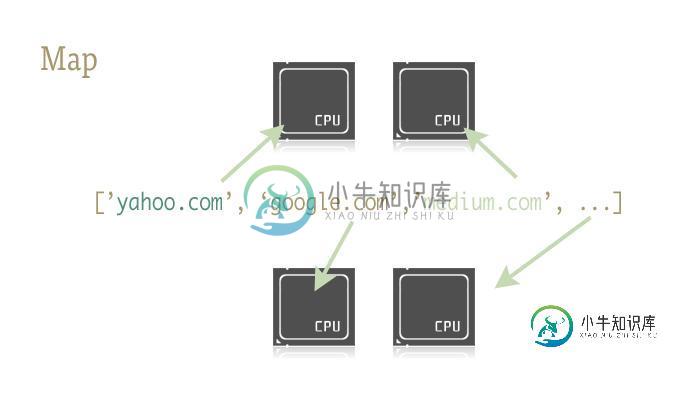用map函数来完成Python并行任务的简单示例
众所周知,Python的并行处理能力很不理想。我认为如果不考虑线程和GIL的标准参数(它们大多是合法的),其原因不是因为技术不到位,而是我们的使用方法不恰当。大多数关于Python线程和多进程的教材虽然都很出色,但是内容繁琐冗长。它们的确在开篇铺陈了许多有用信息,但往往都不会涉及真正能提高日常工作的部分。
经典例子
DDG上以“Python threading tutorial (Python线程教程)”为关键字的热门搜索结果表明:几乎每篇文章中给出的例子都是相同的类+队列。
事实上,它们就是以下这段使用producer/Consumer来处理线程/多进程的代码示例:
#Example.py
'''
Standard Producer/Consumer Threading Pattern
'''
import time
import threading
import Queue
class Consumer(threading.Thread):
def __init__(self, queue):
threading.Thread.__init__(self)
self._queue = queue
def run(self):
while True:
# queue.get() blocks the current thread until
# an item is retrieved.
msg = self._queue.get()
# Checks if the current message is
# the "Poison Pill"
if isinstance(msg, str) and msg == 'quit':
# if so, exists the loop
break
# "Processes" (or in our case, prints) the queue item
print "I'm a thread, and I received %s!!" % msg
# Always be friendly!
print 'Bye byes!'
def Producer():
# Queue is used to share items between
# the threads.
queue = Queue.Queue()
# Create an instance of the worker
worker = Consumer(queue)
# start calls the internal run() method to
# kick off the thread
worker.start()
# variable to keep track of when we started
start_time = time.time()
# While under 5 seconds..
while time.time() - start_time < 5:
# "Produce" a piece of work and stick it in
# the queue for the Consumer to process
queue.put('something at %s' % time.time())
# Sleep a bit just to avoid an absurd number of messages
time.sleep(1)
# This the "poison pill" method of killing a thread.
queue.put('quit')
# wait for the thread to close down
worker.join()
if __name__ == '__main__':
Producer()
唔…….感觉有点像Java。
我现在并不想说明使用Producer / Consume来解决线程/多进程的方法是错误的——因为它肯定正确,而且在很多情况下它是最佳方法。但我不认为这是平时写代码的最佳选择。
它的问题所在(个人观点)
首先,你需要创建一个样板式的铺垫类。然后,你再创建一个队列,通过其传递对象和监管队列的两端来完成任务。(如果你想实现数据的交换或存储,通常还涉及另一个队列的参与)。
Worker越多,问题越多。
接下来,你应该会创建一个worker类的pool来提高Python的速度。下面是IBM tutorial给出的较好的方法。这也是程序员们在利用多线程检索web页面时的常用方法。
#Example2.py
'''
A more realistic thread pool example
'''
import time
import threading
import Queue
import urllib2
class Consumer(threading.Thread):
def __init__(self, queue):
threading.Thread.__init__(self)
self._queue = queue
def run(self):
while True:
content = self._queue.get()
if isinstance(content, str) and content == 'quit':
break
response = urllib2.urlopen(content)
print 'Bye byes!'
def Producer():
urls = [
'http://www.python.org', 'http://www.yahoo.com'
'http://www.scala.org', 'http://www.google.com'
# etc..
]
queue = Queue.Queue()
worker_threads = build_worker_pool(queue, 4)
start_time = time.time()
# Add the urls to process
for url in urls:
queue.put(url)
# Add the poison pillv
for worker in worker_threads:
queue.put('quit')
for worker in worker_threads:
worker.join()
print 'Done! Time taken: {}'.format(time.time() - start_time)
def build_worker_pool(queue, size):
workers = []
for _ in range(size):
worker = Consumer(queue)
worker.start()
workers.append(worker)
return workers
if __name__ == '__main__':
Producer()
它的确能运行,但是这些代码多么复杂阿!它包括了初始化方法、线程跟踪列表以及和我一样容易在死锁问题上出错的人的噩梦——大量的join语句。而这些还仅仅只是繁琐的开始!
我们目前为止都完成了什么?基本上什么都没有。上面的代码几乎一直都只是在进行传递。这是很基础的方法,很容易出错(该死,我刚才忘了在队列对象上还需要调用task_done()方法(但是我懒得修改了)),性价比很低。还好,我们还有更好的方法。
介绍:Map
Map是一个很棒的小功能,同时它也是Python并行代码快速运行的关键。给不熟悉的人讲解一下吧,map是从函数语言Lisp来的。map函数能够按序映射出另一个函数。例如
urls = ['http://www.yahoo.com', 'http://www.reddit.com'] results = map(urllib2.urlopen, urls)
这里调用urlopen方法来把调用结果全部按序返回并存储到一个列表里。就像:
results = [] for url in urls: results.append(urllib2.urlopen(url))
Map按序处理这些迭代。调用这个函数,它就会返回给我们一个按序存储着结果的简易列表。
为什么它这么厉害呢?因为只要有了合适的库,map能使并行运行得十分流畅!

有两个能够支持通过map函数来完成并行的库:一个是multiprocessing,另一个是鲜为人知但功能强大的子文件:multiprocessing.dummy。
题外话:这个是什么?你从来没听说过dummy多进程库?我也是最近才知道的。它在多进程的说明文档里面仅仅只被提到了一句。而且那一句就是大概让你知道有这么个东西的存在。我敢说,这样几近抛售的做法造成的后果是不堪设想的!
Dummy就是多进程模块的克隆文件。唯一不同的是,多进程模块使用的是进程,而dummy则使用线程(当然,它有所有Python常见的限制)。也就是说,数据由一个传递给另一个。这能够使得数据轻松的在这两个之间进行前进和回跃,特别是对于探索性程序来说十分有用,因为你不用确定框架调用到底是IO 还是CPU模式。
准备开始
要做到通过map函数来完成并行,你应该先导入装有它们的模块:
from multiprocessing import Pool from multiprocessing.dummy import Pool as ThreadPool
再初始化:
pool = ThreadPool()
这简单的一句就能代替我们的build_worker_pool 函数在example2.py中的所有工作。换句话说,它创建了许多有效的worker,启动它们来为接下来的工作做准备,以及把它们存储在不同的位置,方便使用。
Pool对象需要一些参数,但最重要的是:进程。它决定pool中的worker数量。如果你不填的话,它就会默认为你电脑的内核数值。
如果你在CPU模式下使用多进程pool,通常内核数越大速度就越快(还有很多其它因素)。但是,当进行线程或者处理网络绑定之类的工作时,情况会比较复杂所以应该使用pool的准确大小。
pool = ThreadPool(4) # Sets the pool size to 4
如果你运行过多线程,多线程间的切换将会浪费许多时间,所以你最好耐心调试出最适合的任务数。
我们现在已经创建了pool对象,马上就能有简单的并行程序了,所以让我们重新写example2.py中的url opener吧!
import urllib2 from multiprocessing.dummy import Pool as ThreadPool urls = [ 'http://www.python.org', 'http://www.python.org/about/', 'http://www.onlamp.com/pub/a/python/2003/04/17/metaclasses.html', 'http://www.python.org/doc/', 'http://www.python.org/download/', 'http://www.python.org/getit/', 'http://www.python.org/community/', 'https://wiki.python.org/moin/', 'http://planet.python.org/', 'https://wiki.python.org/moin/LocalUserGroups', 'http://www.python.org/psf/', 'http://docs.python.org/devguide/', 'http://www.python.org/community/awards/' # etc.. ] # Make the Pool of workers pool = ThreadPool(4) # Open the urls in their own threads # and return the results results = pool.map(urllib2.urlopen, urls) #close the pool and wait for the work to finish pool.close() pool.join()
看吧!这次的代码仅用了4行就完成了所有的工作。其中3句还是简单的固定写法。调用map就能完成我们前面例子中40行的内容!为了更形象地表明两种方法的差异,我还分别给它们运行的时间计时。
# results = [] # for url in urls: # result = urllib2.urlopen(url) # results.append(result) # # ------- VERSUS ------- # # # ------- 4 Pool ------- # # pool = ThreadPool(4) # results = pool.map(urllib2.urlopen, urls) # # ------- 8 Pool ------- # # pool = ThreadPool(8) # results = pool.map(urllib2.urlopen, urls) # # ------- 13 Pool ------- # # pool = ThreadPool(13) # results = pool.map(urllib2.urlopen, urls)
结果:
# Single thread: 14.4 Seconds # 4 Pool: 3.1 Seconds # 8 Pool: 1.4 Seconds # 13 Pool: 1.3 Seconds
相当出色!并且也表明了为什么要细心调试pool的大小。在这里,只要大于9,就能使其运行速度加快。
实例2:
生成成千上万的缩略图
我们在CPU模式下来完成吧!我工作中就经常需要处理大量的图像文件夹。其任务之一就是创建缩略图。这在并行任务中已经有很成熟的方法了。
基础的单线程创建
import os
import PIL
from multiprocessing import Pool
from PIL import Image
SIZE = (75,75)
SAVE_DIRECTORY = 'thumbs'
def get_image_paths(folder):
return (os.path.join(folder, f)
for f in os.listdir(folder)
if 'jpeg' in f)
def create_thumbnail(filename):
im = Image.open(filename)
im.thumbnail(SIZE, Image.ANTIALIAS)
base, fname = os.path.split(filename)
save_path = os.path.join(base, SAVE_DIRECTORY, fname)
im.save(save_path)
if __name__ == '__main__':
folder = os.path.abspath(
'11_18_2013_R000_IQM_Big_Sur_Mon__e10d1958e7b766c3e840')
os.mkdir(os.path.join(folder, SAVE_DIRECTORY))
images = get_image_paths(folder)
for image in images:
create_thumbnail(Image)
对于一个例子来说,这是有点难,但本质上,这就是向程序传递一个文件夹,然后将其中的所有图片抓取出来,并最终在它们各自的目录下创建和储存缩略图。
我的电脑处理大约6000张图片用了27.9秒。
如果我们用并行调用map来代替for循环的话:
import os
import PIL
from multiprocessing import Pool
from PIL import Image
SIZE = (75,75)
SAVE_DIRECTORY = 'thumbs'
def get_image_paths(folder):
return (os.path.join(folder, f)
for f in os.listdir(folder)
if 'jpeg' in f)
def create_thumbnail(filename):
im = Image.open(filename)
im.thumbnail(SIZE, Image.ANTIALIAS)
base, fname = os.path.split(filename)
save_path = os.path.join(base, SAVE_DIRECTORY, fname)
im.save(save_path)
if __name__ == '__main__':
folder = os.path.abspath(
'11_18_2013_R000_IQM_Big_Sur_Mon__e10d1958e7b766c3e840')
os.mkdir(os.path.join(folder, SAVE_DIRECTORY))
images = get_image_paths(folder)
pool = Pool()
pool.map(create_thumbnail,images)
pool.close()
pool.join()
5.6秒!
对于只改变了几行代码而言,这是大大地提升了运行速度。这个方法还能更快,只要你将cpu 和 io的任务分别用它们的进程和线程来运行——但也常造成死锁。总之,综合考虑到 map这个实用的功能,以及人为线程管理的缺失,我觉得这是一个美观,可靠还容易debug的方法。
好了,文章结束了。一行完成并行任务。
-
我正在开始执行器服务,我想知道当任务完成时如何调用函数。我见过这个函数http://docs.oracle.com/javase/8/docs/api/java/util/concurrent/Future.html#isDone-- 但我不确定如何将其连接到我的代码中调用函数<code>endoftheroad() 这是我的代码
-
我的makefile中的一个目标是一个非常耗时的CPU任务。但是我可以分割工作负载并并行运行任务几次,以加快整个过程。 我的问题是make不会等待所有过程完成。 考虑一下这个简单的脚本,名为“代码> MyTask.SH <代码>: 现在,让我们从bash脚本调用它,并使用等待所有任务完成: 产出如预期: 但是在Makefile中尝试相同的方法时: 它不起作用: 当然,我可以创建多个目标,这些目标可
-
说明 调用方法1: $.f2eAct.task(el,options); 函数说明: 该方法完成主要调用joinAndFinish完成任务,会根据接口返回的奖品类型显示不同文案,如卡玛、实物、谢谢参与等。 当获取的奖品数量大于1时,会默认触发 $(".js-package").click(); 事件,所以需要在JS里定义.js-package点击方法。 使用的时候需要在相应dom元素添加 da
-
本文向大家介绍python内置函数:lambda、map、filter简单介绍,包括了python内置函数:lambda、map、filter简单介绍的使用技巧和注意事项,需要的朋友参考一下 lambda lambda可以理解为一种小函数,但是它是一个表达式,而不是一个语句,所以在def不允许出现的地方仍然可以使用lambda函数,例如list里。但是lambda内只可以执行一个表达式。 一个l
-
本文向大家介绍Python map和reduce函数用法示例,包括了Python map和reduce函数用法示例的使用技巧和注意事项,需要的朋友参考一下 先看map。map()函数接收两个参数,一个是函数,一个是序列,map将传入的函数依次作用到序列的每个元素,并把结果作为新的list返回。 举例说明,比如我们有一个函数a(x)=x*2,要把这个函数作用在一个list [1, 2, 3, 4,
-
本文向大家介绍Python实现定时执行任务的三种方式简单示例,包括了Python实现定时执行任务的三种方式简单示例的使用技巧和注意事项,需要的朋友参考一下 本文实例讲述了Python实现定时执行任务的三种方式。分享给大家供大家参考,具体如下: 1.定时任务代码 2.周期性执行任务 3.循环执行命令 更多关于Python相关内容感兴趣的读者可查看本站专题:《Python日期与时间操作技巧总结》、《P

